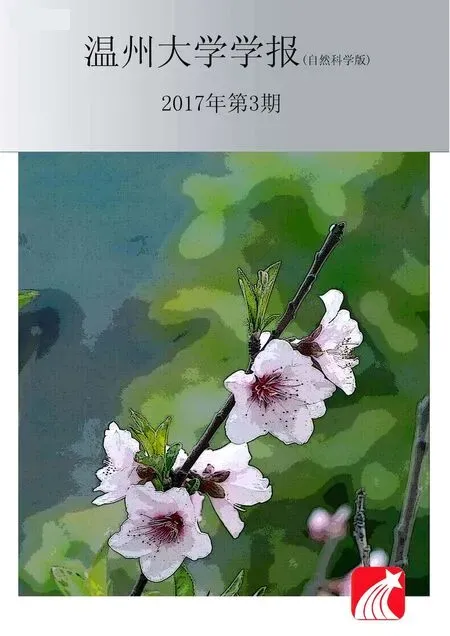利用LC电路耦合多个磁通量子位实现制备Cluster态的有效方案
2017-08-03郭羊青姜年权
郭羊青,姜年权
(温州大学物理与电子信息工程学院,浙江温州 325035)
利用LC电路耦合多个磁通量子位实现制备Cluster态的有效方案
郭羊青,姜年权
(温州大学物理与电子信息工程学院,浙江温州 325035)
基于超导LC电路与多个超导磁通量子位的耦合以及可控时变电磁场(TDEF)对器件之间耦合的调控作用,提出了一步制备Cluster态的有效方案,并给出了该方案在实验上可行性的简要分析.
Cluster 态;磁通量子位;LC电路
近年来,量子计算机(QC)引起了业界的广泛关注.与经典计算机相比,量子计算机可以在实际可观测的时间尺度上执行一些特殊任务[1-2].2001年,Briegel等人[3]介绍了一种新型的单向量子计算,它将信息写入一个Cluster态,并且信息可以通过一个量子位测量来读取,这完全不同于使用一系列一个或两个比特逻辑门的传统量子计算方案.之后,Cluster态的各种应用方案陆续被提出,例如,Cluster态可以用作其它多量子位纠缠态的资源,也可以用于量子非局域性的证明[4].因此,人们开始研究在不同的方案和系统中来制备Cluster态,如Walther等人在量子光学系统[5]通过非确定性局域贝尔测量实现了Cluster态的制备和单向量子计算,在此方案中可实现Cluster态的一步制备,然而制成概率却很低.
在那些探索量子计算的方案中,超导量子位因可适应于大规模量子计算[6-7]而受到广泛关注.目前,已经有很多方案提出利用超导量子位来进行单向量子计算,例如,Tanamoto 等人在文献[8]中提出了所谓的通过利用超导量子位一步制成Cluster态的方案,然而在该方案中,量子位之间是通过固定电容耦合的,这对于初始态的制备和单量子位的测量是非常困难的.也有一些文章[9-11]提出了利用纳米机械谐振子、公共电感或三维腔等作为可控耦合器的改进方案,但是这些方案在实验上仍然具有挑战性.
本文提出了一种有效的耦合超导LC电路和多个超导磁通量子位方案,借助于附加的可控时变电磁场(TDEF),可以实现一步制备Cluster态.在本文的方案中可以允许拓展多个磁通量子位,关于实验上的可行性也进行了分析.
1 系统模型
常规磁通量子位由三个不同的Josephson结组成[12-16],其中一个是其它两个相同的Josephson结的倍(0<α<1).环中的两个相同的结具有相同的Josephson能,(图1).两个相同的结和较小的结的两侧相位差分别为φ1,φ2和φ3.在这里,我们考虑磁通量子位的结构如参考文献[17]中所示,一个额外的电容并联于较小的Josephson结,见图2.假设给磁通量子位施加静态(dc)磁通量Φe,利用超导环的相位约束条件,低相干磁通量子位的Hamiltonian可以写作(假设ħ=1):


图1 磁通量子位的示意图Fig 1 Schematic of Flux Qubit

图2 低相干通量量子位的结构图Fig 2 Schematic of Low-decoherence Flux Qubit
当通过超导环的外置磁通接近磁通量子Φ0的一半时,磁通量子位可以被看作是完美的两能级系统.在持续电流偏置的情况下,Hamiltonian(1)可以重写为[18-19]:


现在,考虑由N个磁通量子位和作为数据总线的LC电路组成的可拓展的量子电路结构(见图3).磁通量子位通过互感Mm(m=1,2,...,N)与LC电路相互作用.假设任何两个邻近的磁通量子位之间的距离如此之大,以至于它们的互感可以忽略不计.在旋波近似下,描述量子位和数据总线LC电路的总的Hamiltonian为[20]:




图3 N个磁通量子位与LC电路耦合的耦合机制(附加的时变电磁场(TDEF)Φ(t)可以应用于任何一个磁通量子位,其中Φ是第m个量子位的偏置磁通)Fig 3 The Coupling Mechanism ofNFlux Qubits and Thecoupling Mechanism of LC Circuit. (Attached Time-varying Electromagnetic Field (TDEF)Φ(t)Can Be Applied to any One of Qubits,WhereΦIs the Bias Magnetic Flux of the Qubit No. M)
2 Cluster态的制备
下面将详细说明用LC电路架构实现Cluster态的方案.考虑所有磁通量子位以相同的强度与LC电路耦合的情况.在相互作用绘景中,耦合系统的Hamiltonian可以写为:


其中相位βm由TDEF确定,λm为与磁通量子位和TDEF相关的Rabi频率.假设β1=β2=...=βN=2π,Hamiltonian(9)可以重写为:

之后,系统总的Hamiltonian可以表示为:

相对应的时间演化算子为[22]:


忽略无关的全局相位因子,时间演化算符化作:


这时,演化算符为:

为了制备Cluster态,我们准备每个磁通量子位的初始态为其中和是特对应于本征值为±1的本征态,合理选择参数满足条件:

这时,我们得到了磁通量子位的Cluster态:

3 讨论与总结
简要评论所给方案在实验上的可行性.首先,讨论本方案的扩展性.LC电路的线性尺寸约为1 cm,而忽略互感效应两个最近磁通量子位之间的距离约为200 μm,显然LC电路可与大约40个磁通量子位相互作用.此外,根据实验[23],我们可选取LC电路和磁通量子位之间的耦合强度当这些条件同时满足时,簇态的制备时间最近的实验[24]表明,磁通量子位的消相干时间已经达到4 μs,很显然,我们有足够的时间来完成对磁通量子位的操作.基于此,本文的方案在实验上是可行的.
本文提出利用超导LC电路耦合多个超导磁通量子位,基于一个额外的可控时变电磁场(TDEF)实现一步制备Cluster态的有效方案,该方案允许电路扩展多个磁通量子位.关于方案的可行性也做了简单讨论.
[1] Shor P W. Polynomial-Time Algorithms for Prime Factorization and Discrete Logarithms on a Quantum Computer [J].SIAM J Sci Statist Comput, 1997, 26(5): 1484-1509.
[2] Grover L K. Quantum computers can search rapidly by using almost any transformation [J]. Phys Rev Lett, 1998,80(19): 4329-4332.
[3] Raussendorf R, Briegel H J. A one-way quantum computer [J]. Phys Rev Lett, 2001, 86(22): 5188-5191.
[4] Scarani V, Acin A, Schenck E, et al. Nonlocality of Cluster states of qubits [J]. Phys Rev A, 2005, 71(4): 042325.
[5] Walther P, Resch K J, Rudolph T, et al. Experimental one-way quantum computing [J]. Nature, 2005, 434(7030):169-176.
[6] Majer J B, Paauw F G, Ter Haar A C J, et al. Spectroscopy on two coupled superconducting flux qubits [J]. Phys Rev Lett, 2005, 94(9): 090501.
[7] You J Q, Nori F. Superconducting circuits and quantum information [J]. Phys Today, 2005, 58(11): 42-47.
[8] Tanamoto T, Liu Y X, Fujita S, et al. Producing Cluster states in charge qubits and flux qubits [J]. Phys Rev Lett, 2006,97(23): 230501.
[9] You J Q, Wang X B, Tanamoto T, et al. Efficient one-step generation of large Cluster states with solid-state circuits [J].Phys Rev A, 2007, 75: 052319.
[10] Xue Z Y, Wang Z D. Simple unconventional geometric scenario of one-way quantum computation with superconducting qubits inside a cavity [J]. Phys Rev A,2007, 75(6): 064303.
[11] Chen G, Chen Z, Yu L, et al. One-step generation of Cluster states in superconducting chargequbits coupled with a nanomechanical resonator [J]. Phys Rev A, 2007, 76(2): 024301.
[12] Storcz M J, Wilhelm F K. Design of realistic switches for coupling superconducting solid-state qubits [J]. Appl Phys Lett, 2003, 83(12): 2387-2389.
[13] Chiorescu I, Nakamura Y, Harmans C J P M, et al. Coherent quantum dynamics of a superconducting flux qubit [J].Science, 2003, 299(5614): 1869-1871.
[14] You J Q, Nakamura Y, Nori F. Fast two-bit operations in inductively coupled flux qubits [J]. Phys Rev B, 2005, 71(2):024532.
[15] Grajcar M, Izmalkov A, Van Der Ploeg S H W, et al. Four-qubit device with mixed couplings [J]. Phys Rev Lett,2006, 96(4): 047006.
[16] Saito S, Thorwart M, Tanaka H, et al. Multiphoton transitions in a macroscopic quantum two-state system [J]. Phys Rev Lett, 2004, 93(3): 037001.
[17] You J Q, Hu X, Ashhab S, et al. Low-decoherence flux qubit [J]. Phys Rev B, 2007, 75(14): 140515.
[18] Mooij J E, Orlando T P, Levitov L, et al. Josephson Persistent-Current Qubit [J]. Science, 1999, 285(5430):1036-1039.
[19] Orlando T P, Mooij E, Tian L, et al. Superconducting persistent-current qubit [J]. Phys Rev B, 1999, 60(22):15398-15413.
[20] Liu Y X, Wei L F, Johansson J R, et al. Superconducting qubits can be coupled and addressed as trapped ions [J].Phys Rev B, 2007, 76: 144518.
[21] Liu Y X, Sun C P, Nori F. Scalable superconducting qubit circuits using dressed states [J]. Phys Rev A, 2006, 74(5):052321.
[22] Zheng S B. Quantum-information processing and multiatom-entanglement engineering with a thermal cavity [J].Phys Rev A, 2002, 66: 060303.
[23] Johansson J, Satio S, Meno T, et al.Vacuum Rabi oscillations in a macroscopic superconducting qubit LC oscillator system [J]. Phys Rev Lett, 2006, 96(12): 127006.
[24] Clarke J, Wilhelm F K. Superconducting quantum bits [J]. Nature, 2008, 453(7198): 1031-1042.
Abstract:An effective scheme for the one-step preparation of the Cluster states based on a superconducting LC circuit coupling to multiple superconducting flux qubits and a controllable time-dependent electromagnetic field (TDEF) is proposed in this paper. A brief analysis on the feasibility of the experimental scheme is exposed as well.
Keywords:Cluster States; Flux Qubits; LC Circuit
(编辑:王一芳)
An Efficient Scheme for Generating Cluster States with Multi-qubits Coupled to a Superconducting LC Circuit
GUO Yangqing, JIANG Nianquan
(College of Physics and Electronic Information Engineering, Wenzhou, China 325035)
O413.2
A
1674-3563(2017)03-0043-06
10.3875/j.issn.1674-3563.2017.03.007 本文的PDF文件可以从xuebao.wzu.edu.cn获得
2017-03-14
郭羊青(1991-),男,安徽芜湖人,硕士研究生,研究方向:量子信息物理
